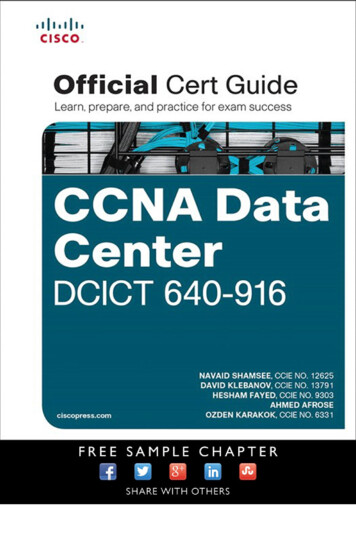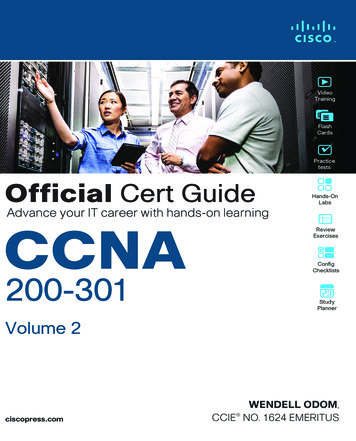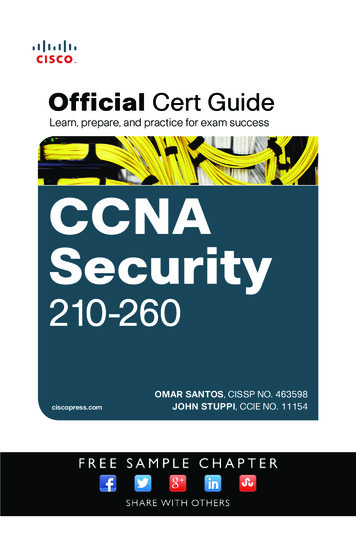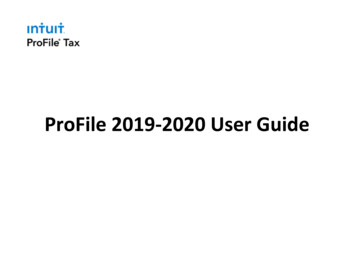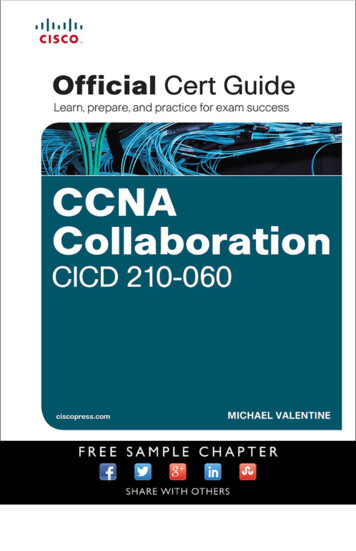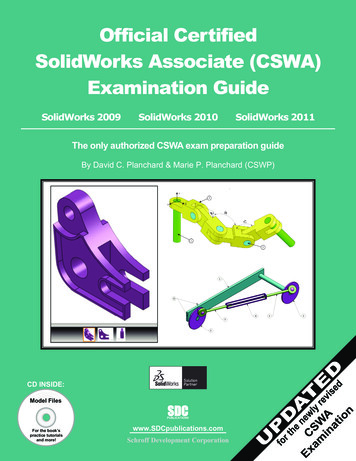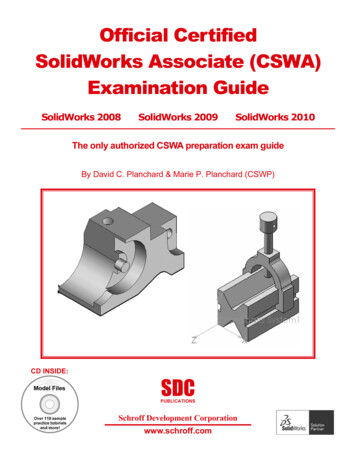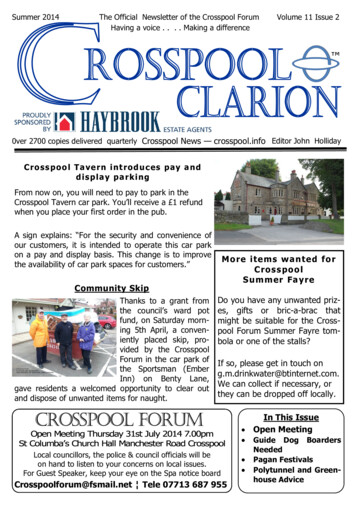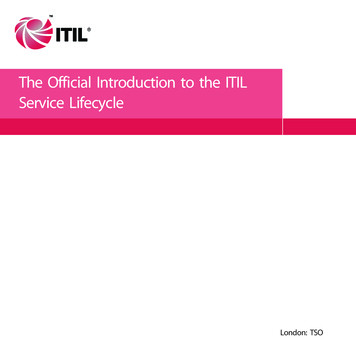
Transcription
The Official Introduction to the ITILService LifecycleLondon: TSO
Published by TSO (The Stationery Office) and available from:Onlinewww.tsoshop.co.ukMail,Telephone, Fax & E-mailTSOPO Box 29, Norwich NR3 1GNTelephone orders/General enquiries: 0870 600 5522Fax orders: 0870 600 5533E-mail: customer.services@tso.co.ukTextphone: 0870 240 3701TSO Shops16 Arthur Street, Belfast BT1 4GD028 9023 8451 Fax 028 9023 540171 Lothian Road, Edinburgh EH3 9AZ0870 606 5566 Fax 0870 606 5588TSO@Blackwell and other Accredited AgentsPublished with the permission of the Office of Government Commerce on behalf of the Controller of Her Majesty’s Stationery Office. Crown Copyright 2007This is a Crown copyright value added product, reuse of which requires a Click-Use Licence for value added material issued by OPSI.Applications to reuse, reproduce or republish material in this publication should be sent to OPSI, Information Policy Team, St Clements House, 2-16 Colegate,Norwich, NR3 1BQ, Tel No (01603) 621000 Fax No (01603) 723000, E-mail: hmsolicensing@cabinet-office.x.gsi.gov.uk , or complete the application form onthe OPSI website ce-information/index.htmOPSI, in consultation with Office of Government Commerce (OGC), may then prepare a Value Added Licence based on standard terms tailored to yourparticular requirements including payment termsThe OGC logo is a Registered Trade Mark of the Office of Government Commerce in the United KingdomITIL is a Registered Trade Mark of the Office of Government Commerce in the United Kingdom and other countriesThe swirl logo is a Trade Mark of the Office of Government CommerceFirst published 2007ISBN 9780113310616Printed in the United Kingdom for The Stationery OfficeN5635491 c6008/07
iii ContentsList of figuresvi2.7ITIL conformance or compliance – practiceadaptation13List of tablesviii2.8Getting started – Service LifecycleprinciplesOGC’s forewordix3Chief Architect’s forewordxThe ITIL Service ManagementLifecycle – core of ns and Processes acrossthe lifecycle20Service Strategy – governance anddecision-making23A historical perspective of IT servicemanagement and ITIL34.1Strategic assessment251.2ITIL today34.2Developing strategic capabilities271.3The ITIL value proposition44.3Service Provider types – matchingneed to capability271.4The ITIL service managementpractices44.4Services as assets – value creation281.5What is a service?54.5Defining the market space291.6Navigating the ITIL ServiceManagement Lifecycle4.6Service Portfolios304.7Service outsourcing – practicaldecision-making33Core guidance topics594.8Return on investment (ROI)352.1Service Strategy114.9Financial Management362.2Service Design114.10Increasing service potential382.3Service Transition124.11Organizational development392.4Service Operation122.5Continual Service Improvement122.6Lifecycle quality control13
iv Contents5Service Design – building structuralservice integrity437Service Operation7.1Business value945.1Business value467.2Event Management945.2Five aspects of Service Design467.3Incident Management965.3Identifying service requirements477.4Request Fulfilment995.4Service Design models487.5Problem Management1015.5Delivery model options497.6Access Management1055.6Service Catalogue Management507.7Service Operation functions1065.7Service Level Management527.8IT Operations Management1165.8Capacity Management557.9Application Management1175.9Availability Management607.105.10IT Service Continuity Management64Service Operation and projectmanagement1215.11Information Security Management665.12Supplier Management70Assessing and managing risk inService Operation122Operational staff in Service Designand Transition122Continual Service Improvement1257.117.12691Service Transition – preparing forchange736.1Transition Planning and Support766.2Change Management806.3Asset and ConfigurationManagement836.46.5Release and DeploymentManagement86Service Validation and TestingReleases8888.1Purpose of CSI1258.2CSI objectives1268.3Business drivers1288.4Technology drivers1288.5Service measurement1298.6Continual Service Improvementprocesses129Service reporting1408.7
Contents 9Complementary guidance9.110ITIL and other frameworks, practicesand standardsThe ITIL Service ManagementModel14514514910.1Model element types14910.2Basic elements15110.3Creating a service15510.4Strategy generation15510.5Deciding the course of action tocreate a new service158Acronyms173Glossary177Index227v
vi List of figuresFigure 2.1The Deming Quality CycleFigure 6.1The Service Transition processFigure 3.1The ITIL Service LifecycleFigure 6.2Normal Change ModelFigure 3.2Process architectureFigure 6.3Figure 3.3Continual feedback loopService Asset and ConfigurationManagement – interfaces to the lifecycleFigure 4.1Service Provider capabilities and resourcesFigure 6.4Example of a release packageFigure 4.2Actionable components of service definitionsin terms of utilityFigure 6.5Service testing and validationFigure 7.1The Event Management processFigure 4.3Service PortfolioFigure 7.2The Incident Management process flowFigure 4.4Elements of a Service Portfolio and ServiceCatalogueFigure 7.3The Problem Management process flowFigure 7.4Single monitor control loopFigure 4.5Service Portfolio managementFigure 7.5Complex monitor control loopFigure 4.6Business impact and ROI outcomeFigure 7.6ITSM monitor control loopFigure 5.1Design dependenciesFigure 7.7Figure 5.2Service Catalogue elementsRole of Application Management in theapplication lifecycleFigure 5.3The Service Level Management processFigure 8.1Continual Service Improvement modelFigure 5.4Component-based Service Level PackageFigure 8.2Seven-step Improvement ProcessFigure 5.5Capacity Management elementsFigure 8.3Number of incident tickets opened over timeFigure 5.6The Availability Management processFigure 8.4Service reporting processFigure 5.7Relationship between levels of availabilityand overall costsFigure 10.1Service Management Model element typesFigure 10.2Figure 5.8Service Continuity lifecycleService Lifecycle governance and operationalelementsFigure 5.9IT Security Management processFigure 10.3Typical Type I Service Provider interactionsFigure 5.10Supplier Management – roles and interfacesFigure 10.4Type II Service Provider interactionsFigure 10.5Type III Service Provider interactionsFigure 10.6Basic Service Management Model processelements
List of figures Figure 10.7ITIL Service Lifecycle main practice elementsFigure 10.8Forming and formulating a Service StrategyFigure 10.9The Service PortfolioFigure 10.10 Stage 1 – Service Strategy elementsFigure 10.11 Stage 2 – Design service solutionFigure 10.12 Stage 3 – Transition the serviceFigure 10.13 Change Management elementsFigure 10.14 Normal Change Management processFigure 10.15 Information flows at the Service TransitionstageFigure 10.16 Stage 4 – Operate the serviceFigure 10.17 The Event Management processFigure 10.18 The Incident Management process flowFigure 10.19 Information flow in the Service OperationstageFigure 10.20 Stage 5 – Continual Service ImprovementFigure 10.21 Information flow within Continual ServiceImprovementFigure 10.22 Integrated lifecycle elements flowFigure 10.23 Layered view of the main elements in theService Lifecyclevii
viii List of tablesTable 2.1Roles and core guidesTable 4.1Factors in strategic assessmentTable 4.2Types of sourcing structuresTable 4.3Example of increased Service PotentialTable 4.4Basic organizational structures for types ofservice strategiesTable 5.1Delivery model optionsTable 8.1Service metric examples
OGC’s forewordAs co-founder of the ITIL concept and leader of its earlydevelopment, I’m delighted by the positive impact it hasmade on companies and organizations around the world.What began as a UK government initiative to set out anefficient, successful and reliable approach to servicemanagement is now a global endeavour, withpublications, training and support tools available in variouslanguages. Of course, successful growth doesn’t happenby chance and ITIL has proven itself many times overthrough the benefits it brings to the businesses thatembed its practices.Since its creation in the late 1980s, ITIL has beendeveloped to keep up to date with a constantly changingservice management environment. Here in the latestversion, I am pleased to see a top-quality product.Consultation with experts on a global scale brings youleading practices, identified through experience andbrought together with the skills and expertise of ourpublishing partner, The Stationery Office (TSO).I believe ITIL will continue to play an important role withingovernment as an effective standard framework fordelivery. However, the real value in ITIL is that its benefitsare available to every organization, large or small, with agenuine desire to deliver a high-performing serviceprovision. May your organization be one of those!John StewartOffice of Government Commerceix
x Chief Architect’s forewordThis book is dedicated to the people who practise ITservice management. Through their knowledge andexperiences we have shaped the present and can seefurther toward the future along our journey to serviceexcellence.Over the past two decades the world of IT has changeddramatically. The IT Infrastructure Library framework hasgrown along with it and has shaped a community ofpractice that has spawned an entire industry. What hasn’tchanged in all that time is the need for us as practitionersof service management to learn how best practices evolveand how they support and influence the customer’ssuccesses or failures.In a world of growing complexity, choice and globalization,ITIL has remained at the heart of the industry, growing andevolving to meet the needs of service providers. Thecurrent version of ITIL is a product of this evolution.Within the pages of this book, we will introduce ITIL to thenovice, further educate the practitioner and transform ourunderstanding of IT service management best practices.This book captures the basic concepts of the ITIL ServiceLifecycle and its benefits. It serves as a reference to ITILservice management practices, but should not beconsidered a substitute for the ITIL core practice set.It is from here we begin the journey into the ITIL servicemanagement practices.Sharon TaylorChief Architect, ITIL Service Management Practices
PrefaceLife-cycle (noun) – The various stages through which aliving thing passes (Kernerman English MultilingualDictionary)The very term ‘lifecycle’ is used to describe the evolutionof many living things in this world from their creation toexpiration. The time between creation and expiration isthe ‘journey’.We need only look at our own life journeys to see a livingexample.Creation – the first part of our journey. As an embryodevelops, its life blueprint is being established through thearchitecture of its DNA. The embryo’s genetic structure willdictate its capability, propensity for immunity orvulnerability to disease, and certain personalitycharacteristics it will carry throughout life.Childhood – the formative stage. We are influenced by ourexposure to the world around us and can influence ourlife blueprint in how we manifest and integrate ourselveswith the world around us. Our understanding of ourneeds, both for growth and creativity, are our‘requirements’ that allow us to create value for ourselvesand those who come into contact with us.Adulthood – where we hone our skills and perform withinexpected societal parameters. We strive to improve ourcapabilities continually and define our value. By this time,we have built a complex network of relationships anddependencies to others. The world we live in has becomefar more complex than in childhood and managing ourlives more challenging.If you replace the human metaphor above with thelifecycle of service management, you will see manysimilarities. This is because the ITIL Service Lifecyclerepresents the same evolution – from creation toexpiration – and the stages in the ITIL Service Lifecycle arewhat fall in between.We often forget that services are living things. Theyrequire sustenance to survive, they must continually adaptand evolve with changing needs of the business, and theywill pass through various stages over their lifetime.Services are constrained by their genetic blueprint – risks,financial investment, culture and economics – but shouldevolve to influence their value through interaction,evolution, dependencies and relationships, and to exploitthese for positive outcomes.This book will take you through these Service Lifecyclestages and show how to apply the knowledge containedin the ITIL core lifecycle publications.xi
Introduction1
1 Introduction1.1 A HISTORICAL PERSPECTIVE OF ITSERVICE MANAGEMENT AND ITILthe itSMF has members worldwide as ITIL’s popularitycontinues to grow.IT service management (ITSM) evolved naturally as servicesbecame underpinned in time by the developingtechnology. In its early years, IT was mainly focused onapplication development – all the new possibilitiesseeming to be ends in themselves. Harnessing theapparent benefits of these new technologies meantconcentrating on delivering the created applications as apart of a larger service offering, supporting the businessitself.A formal standard for ITSM, The British Standard 15000,largely based on ITIL practices, was established andfollowed by various national standards in numerouscountries. Since then the ISO 20000:2005 Standard wasintroduced and gained rapid recognition globally.During the 1980s, as the practice of service managementgrew, so too did the dependency of the business. Meetingthe business need called for a more radical refocus for anIT service approach and the ‘IT help desk’ emerged to dealwith the frequency of issues suffered by those trying touse IT services in delivery of their business.At the same time, the UK government, fuelled by a needfor finding efficiencies, set
2.3 Service Transition 12 2.4 Service Operation 12 2.5 Continual Service Improvement 12 2.6 Lifecycle quality control 13 2.7 ITIL conformance or compliance – practice adaptation 13 2.8 Getting started – Service Lifecycle principles 14 3 The ITIL Service Management Lifecycle – core of practice 17 3.1 Functions and Processes across the .


